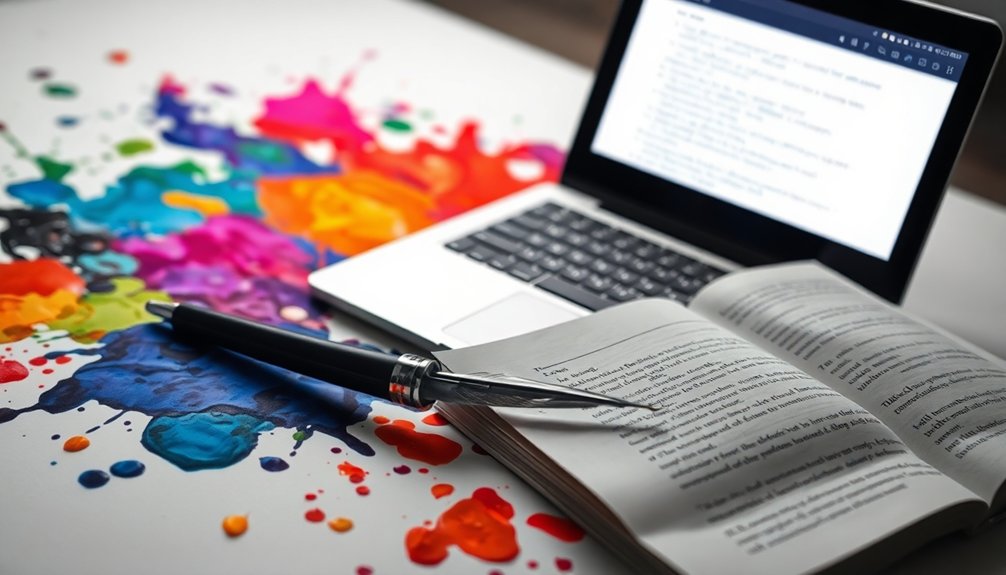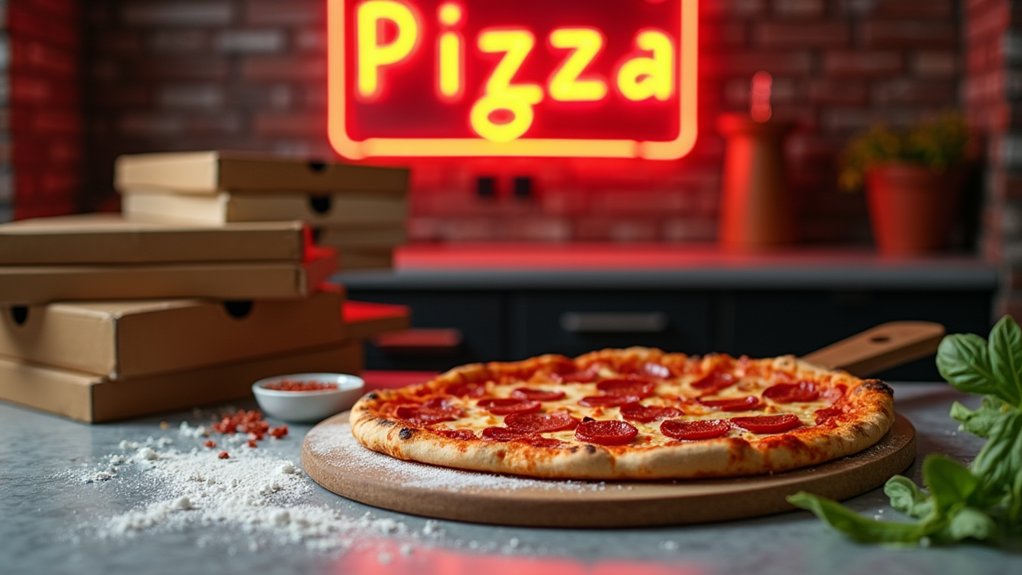Yes, a machine can write poetry! It learns by analyzing vast datasets of human-written poems and uses advanced algorithms to capture poetic forms, styles, and emotions. Techniques like natural language processing and neural networks, such as RNNs and LSTMs, allow AI to understand grammar and make creative word choices. Surprisingly, readers often find AI-generated poems beautiful and emotionally resonant. However, the debate around AI's creativity and artistic value continues. If you're curious about specific examples and the ongoing impact of AI on the art world, there's so much more to explore!
Key Takeaways
- AI poetry generation utilizes vast datasets of human-authored poems, allowing machines to learn various styles and themes.
- Neural networks like RNNs and LSTMs enable AI to process language nuances, improving the quality of generated poetry.
- Studies indicate that readers often prefer AI-generated poems for their rhythm, creativity, and emotional resonance.
- AI's role in creative writing enhances human creativity while challenging traditional notions of artistic value.
- The ongoing debate about AI's true creativity continues to shape perceptions of art and its future in creative fields.
Understanding AI Poetry Generation
Understanding AI poetry generation starts with recognizing the vast datasets that form its foundation. These datasets consist of countless human-authored poems, showcasing a rich variety of styles, themes, and emotions.
You'll find that the diversity within these datasets is essential; it enables the AI to learn different poetic forms effectively. By training on extensive collections, AI models grasp the grammar, syntax, and semantics of language, enhancing their ability to recognize patterns and replicate stylistic elements.
Neural networks, like RNNs and LSTMs, process this sequential data, refining their parameters to minimize errors. This iterative learning helps the AI understand poetry's structure and flow, ultimately preparing it to generate text that resonates with human-like creativity and coherence. Furthermore, the use of neural networks allows for a more nuanced understanding of poetic devices, which enhances the overall quality of the generated poetry.

Techniques Behind AI Poetry
AI poetry generation relies on a variety of techniques that enhance its creative output. Large datasets of existing poems train algorithms, exposing them to diverse styles, themes, and emotions. You'll find neural networks like Recurrent Neural Networks (RNNs) and Long Short-Term Memory networks (LSTMs) commonly employed, refining their understanding of language nuances and syntax. Natural Language Processing (NLP) plays an essential role, analyzing vast text data through tokenization and sentiment analysis to generate meaningful poetry. Creative algorithms introduce unpredictability, using randomization to explore varied word choices and structures. Advanced machine learning techniques, like Word2vec and topic modeling, quantify thematic content, while deep learning models like GPT-3 generate poetry based on prompts, combining multiple methods to enhance accuracy and creativity. These AI-driven algorithms are trained on large volumes of text data to understand language patterns and generate original pieces.
Evaluating AI-Generated Poems

Evaluating poetry generated by machines has become a fascinating intersection of technology and art, prompting readers and critics alike to reconsider what defines poetic merit. Studies reveal that many readers prefer AI-generated poems for their rhythm and beauty, often mistaking them for human works. These poems excel in attributes like creativity and emotional quality, making them appealing in our fast-paced world. Notably, participants found AI poems to have higher scores in creativity, atmosphere, and emotional quality compared to their human counterparts.
Here's a comparison of AI-generated versus human-authored poems:
| Attribute | AI-Generated Poems | Human-Authored Poems |
|---|---|---|
| Rhythm | High | Variable |
| Emotional Resonance | Strong | Complex |
| Clarity | Clear | Ambiguous |
This evaluation shows that AI poetry can engage readers effectively, challenging traditional notions of artistic value.
Impact on the Poetry Landscape
In recent years, the poetry landscape has transformed dramatically, influenced by the rise of AI-generated works. Many readers now prefer the simplicity and clarity of these poems, often rating them favorably when unaware of their origin. However, once they learn a poem is AI-generated, their ratings drop, revealing a bias against machine authorship. This shift affects how poetry is taught and evaluated in classrooms, challenging educators to adapt.
- AI poetry can evoke strong emotions.
- Readers often misinterpret complex human poems as incoherent.
- AI can assist in creative writing processes.
- Transparency about authorship is vital.
- The debate on AI's true creativity continues.
Moreover, readers struggled to distinguish between AI and human poetry, highlighting the challenges faced in recognizing artistic authenticity. These factors reshape our understanding and appreciation of poetry today.

Notable Examples of AI Poetry

The evolving landscape of poetry has opened doors to remarkable AI-generated works that challenge traditional notions of authorship and creativity. One notable project is the Aum Golly series, created in collaboration with human authors. The first book was generated in just 24 hours using GPT-3, with a sequel crafted in 12 hours through ChatGPT and Midjourney. These books, available in English and Finnish, are described as funny, touching, and inventive. Moreover, the ability of AI to generate poetry using statistical methods demonstrates its potential to innovate within the art form.
Another example is the Duluth Poems, where ChatGPT generated seven poems, including haikus, illustrated by DALL-E 2. This project showcases AI's ability to evoke specific emotions and moods while mimicking various styles, illustrating how AI can enhance and diversify poetic expression.
Future of AI in Creative Arts
AI is increasingly shaping the future of creative arts, offering exciting possibilities for artists and audiences alike.
As you explore this evolving landscape, you'll discover how AI transforms creativity through various avenues:
- AI algorithms analyze data to inspire unique visual and musical creations.
- Generative AI produces new ideas, pushing artistic boundaries.
- AI-driven installations and performances introduce fresh art forms.
- The blur between human and AI art challenges traditional perceptions.
- Collaborative tools enhance artists' skills while expanding their creative horizons.
With these advancements, you'll find that AI isn't just a tool; it's a collaborator that redefines what art can be, encouraging innovative expressions and accessibility in the creative domain. The collaboration between artists and AI democratizes art creation, providing access to diverse audiences and fostering groundbreaking artistic movements.
Embrace the future, and let AI inspire your artistic journey!
Frequently Asked Questions
Can Ai-Generated Poetry Evoke Genuine Human Emotions?
Yes, AI-generated poetry can evoke genuine human emotions. You might feel happiness, sadness, or surprise when reading these poems, especially if you're unaware of their origin.
The linguistic structure plays a significant role in how you emotionally respond. However, knowing a poem's created by AI can shift your perception, potentially leading to disconnection.
While AI lacks personal experience, its creations can still resonate with you on a fundamental emotional level.
How Does AI Poetry Differ From Traditional Human Poetry?
Think of AI poetry as a polished mirror, reflecting human creativity but lacking its depth.
When you read AI-generated poems, you'll notice their straightforwardness and emotional clarity, making them accessible.
In contrast, traditional human poetry often weaves complex layers and metaphors, inviting deeper interpretation.
While AI excels in rhythm and beauty, it struggles with the nuanced emotions that give human poetry its lasting resonance and richness.
What Are the Limitations of AI in Poetry Creation?
AI in poetry creation faces several limitations.
You'll notice it struggles with emotional depth; it can't truly feel, making its poems lack the resonance you find in human work.
Contextual coherence is another challenge; AI often fails to maintain a seamless flow.
Plus, originality suffers, as AI relies on existing material, offering little in the way of unique insights.
Finally, ethical concerns arise around the value of human creativity versus algorithmic outputs.
Can AI Collaborate With Human Poets Effectively?
Can you imagine a world where machines and humans create poetry together?
AI can effectively collaborate with you, enhancing your creativity through innovative ideas and pattern recognition.
By using a Hybrid Approach, you harness AI's strengths while maintaining your artistic vision.
This partnership not only boosts your productivity but also pushes the boundaries of poetic expression.
Embracing this collaboration could lead to unique, unexplored styles that redefine what poetry means today.
Is AI Poetry Considered Art or Just Algorithmic Output?
You might wonder if AI poetry is truly art or merely algorithmic output.
While AI can generate structurally sound poems, its lack of emotional depth often leads to skepticism about its artistic value.
You'll find that many people perceive AI-generated works as less innovative, attributing this to the belief that machines can't capture human experiences.
Ultimately, it's up to you to decide if AI poetry deserves a place in the artistic landscape.





